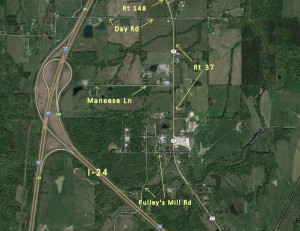Pulley’s Mill is now a crossroads hamlet in section 34 of Southern township. The mill is gone, but once its two-story structure housing machinery run by steam employed many workmen and their cottages clustered around. The mill was built by Barton and Daniel Pulley, brothers, in 1854 and was one of the first in the county to use the new power. Their water came from a branch of the Saline nearby. In 1875 the force that worked Pulley’s mill included I. K. Taylor, miller; W. F. Pearson, engineer; and J. E. Moake, mechanic.
 A post office was secured October 28, 1864, and John W. Todd was appointed the first postmaster. Among the others was Jesse J. Fly (1846-1928), the country doctor who lived near Fountain church. The service Mr. Todd instituted was continued until July 14, 1905.
A post office was secured October 28, 1864, and John W. Todd was appointed the first postmaster. Among the others was Jesse J. Fly (1846-1928), the country doctor who lived near Fountain church. The service Mr. Todd instituted was continued until July 14, 1905.
With mill and post office, Pulley’s Mill made an ideal opening for a young merchant, and in 1885 John Bell Hudgens left his father’s farm to become a merchant at the little town. With Zachariah Hudgens as partner, the son purchased the flour mill after a few years. This firm operated the mill for a while at the original location, then the railroad was built south and the new town of Goreville boomed. The Hudgens interests, mill and all, were transferred there and operated until John Bell Hudgens became cashier of the First National bank of Goreville when it was organized.
Meantime Barton Pulley was still engaged in milling. He took his family to old Stonefort about 1871, and built a mill that he moved with the town to the railroad two years later. His sons were early merchants at Stonefort.
The Pulley family has given many public officials to the county. Robert L. Pulley (1814-1865) was clerk of Saline Precinct in August 1839 when the county division was voted; was associate justice of the county court from 1849 to 1857, and county treasurer during the last two years of that service. He joined with William H. Willeford the printer in building a church, sometimes known as Pulley’s chapel. James D. Pulley was appointed drainage commissioner in 1852 to sell the county’s swamp lands, and later went to the legislature while he lived in Johnson County. Both these prominent citizens were named in the charivari indictment written at Marion courthouse by John A. Logan.
Lewis Buchanan Pulley was county surveyor from 1888 to 1892, then circuit clerk from 1900 to 1912. Three consecutive terms was a record at that time, but it was matched immediately by Mr. Pulley’s successor and son-in-law, Leslie O. Caplinger. Mr. Pulley was son and grandson of Washington and William Pulley who made their land entries in East Marion Township during the thirties. William and Washington Pulley were judge and clerk at the polls of Saline precinct in 1838.
Pulley’s Mill has a place of historical interest suitably marked by the Daughters of the American Revolution. The marker reads: “Second camp of George Rogers Clark, on his March from Fort Massac to Fort Kaskaskia, 1778.” A fine spring under the hill on a level creek bank made an ideal campsite, used by travelers from the Ohio into the prairie country. This trail may well have been what Colonel Clark called in 1778 “a hunter’s road.” He may have learned of the spring’s location either from previous study of the country or from the guide John Saunders whose services he commandeered.
The Business and Professional Woman’s Club of Marion use a gavel made from an oak tree that stood near Colonel Clark’s camp at Pulley’s Mill. It was presented by W. S. Burkhart.
(Extracted from Pioneer Folks and Places, Barbara Barr Hubbs, 1939, on sale at the Williamson County Museum)
